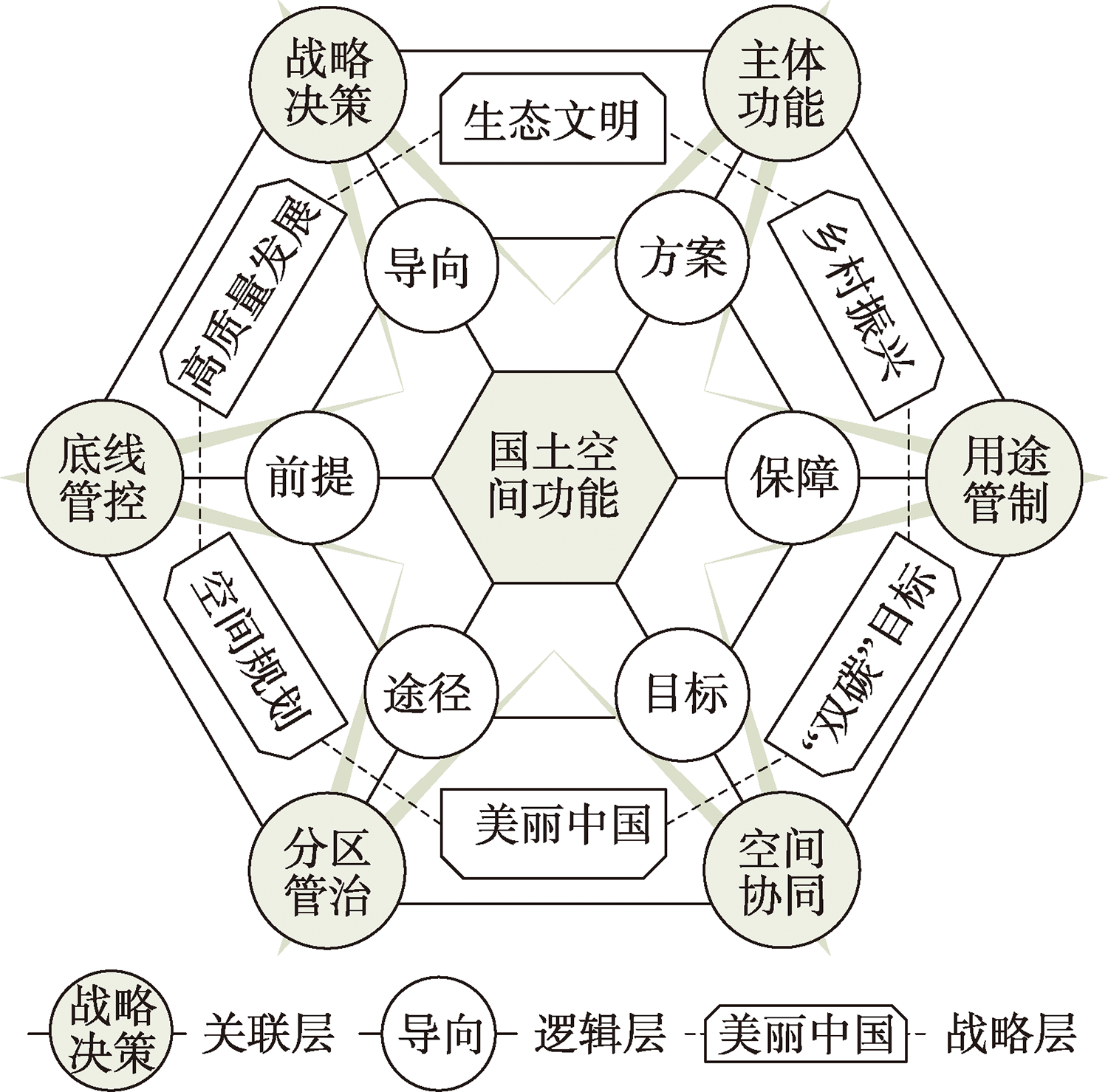

新时代国土空间功能的科学认知与研究框架
|
邹利林(1984- ),男,湖北监利人,博士,副教授,研究方向为土地利用与乡村振兴、国土空间冲突与治理。E-mail: zoull@igsnrr.ac.cn |
收稿日期: 2021-12-12
修回日期: 2022-05-26
网络出版日期: 2022-12-28
基金资助
国家自然科学基金项目(41901212)
Scientific cognition and research framework of territorial space function in the New Era
Received date: 2021-12-12
Revised date: 2022-05-26
Online published: 2022-12-28
中国正面临着城乡土地结构失衡、国土空间开发失序、地域主体功能失调等诸多问题,这给新时代国土空间开发、保护与治理带来巨大压力和挑战。国土空间功能作为架构国土空间规划理论体系与实践框架的重要内容,也是考察人与自然和谐共生的重要刻度。基于当前重大战略决策的理论与现实诉求,指出地域功能是衍生国土空间功能概念的逻辑起点,人地关系地域系统理论是构建国土空间功能理论体系的内核,而空间整合是国土空间功能理论体系演进的重要向度;从战略决策、主体功能、底线管控、用途管制、分区管治、空间协同等六个方面构建了国土空间功能理论认知模型(雪花模型),辨析了新时代国土空间功能研究的科学价值;对新时代国土空间功能研究的学理认知、分类识别、演化机制、动态权衡等基本问题域进行讨论,初步构建了国土空间功能的研究框架。

邹利林 , 章丽君 , 梁一凡 , 文琦 . 新时代国土空间功能的科学认知与研究框架[J]. 自然资源学报, 2022 , 37(12) : 3060 -3072 . DOI: 10.31497/zrzyxb.20221203
With the rapid urbanization and industrialization, China is facing many problems, such as the imbalance between urban and rural land structure, the disorder of territorial spatial development, and the regional difference. Especially, the confusion, conflict, and degradation of territorial space function are very serious, which has brought great pressure and challenges to the territorial spatial development, protection, and governance in the New Era. As an important part of the theoretical system and practical framework of structured territorial spatial planning, territorial space function referred to develop, control, and protect space according to a scheme confirmed by territorial spatial planning under the specific regional spatial scope and the human-environment interaction, with the purpose of satisfying human demands or enhancing human well-being, so as to provide utility of different products and services for human society directly or indirectly. The territorial space function was also an important scale to investigate the harmonious coexistence between human and nature. To establish the theory and reality demands of the current major strategic decisions, this paper pointed out that the regional function theory was the logical starting point of territorial space function, the theory of territorial system of human-earth interaction was the core of constructing the theory system of territorial space function, and the spatial integration was an important dimension in the evolution of the theoretical system of territorial space function. A theoretical cognitive model of territorial space function (snowflake model) was constructed from the aspects of strategic decision-making, major function, baseline control, use regulation, zoning governance and spatial coordination, in which the strategic decision-making was the policy guidance for the territorial space function, the major function was the overall plan for the spatial function pattern, the baseline control was the basic premise to realize the territorial space function, the use regulation was the institutional guarantee to strengthen the territorial space function, the zoning governance was an effective way to optimize the territorial space function, and the spatial coordination was the fundamental goal of regulating the territorial space function. Facing the needs of serving national important strategic decisions, optimizing territorial spatial development pattern and sustainable development, this paper discussed the basic problem domains of territorial space function research in the New Era, such as theoretical cognition, classification and identification, evolution mechanism and dynamic trade-off, by which a preliminary research framework of territorial space function was constructed.

| [1] |
傅伯杰. 国土空间生态修复亟待把握的几个要点. 中国科学院院刊, 2021, 36(1): 64-69.
[
|
| [2] |
黄贤金. 美丽中国与国土空间用途管制. 中国地质大学学报: 社会科学版, 2018, 18(6): 1-7.
[
|
| [3] |
|
| [4] |
曹小曙. 基于人地耦合系统的国土空间重塑. 自然资源学报, 2019, 34(10): 2051-2059.
[
|
| [5] |
|
| [6] |
樊杰. 中国主体功能区划方案. 地理学报, 2015, 70(2): 186-201.
[
|
| [7] |
刘彦随. 中国乡村振兴规划的基础理论与方法论. 地理学报, 2020, 75(6): 1120-1133.
[
|
| [8] |
龙花楼, 陈坤秋. 基于土地系统科学的土地利用转型与城乡融合发展. 地理学报, 2021, 76(2): 295-309.
[
|
| [9] |
彭建, 吕丹娜, 董建权, 等. 过程耦合与空间集成: 国土空间生态修复的景观生态学认知. 自然资源学报, 2020, 35(1): 3-13.
[
|
| [10] |
钟镇涛, 张鸿辉, 洪良, 等. 生态文明视角下的国土空间底线管控: “双评价”与国土空间规划监测评估预警. 自然资源学报, 2020, 35(10): 2415-2427.
[
|
| [11] |
张晓玲, 吕晓. 国土空间用途管制的改革逻辑及其规划响应路径. 自然资源学报, 2020, 35(6): 1261-1272.
[
|
| [12] |
|
| [13] |
|
| [14] |
|
| [15] |
|
| [16] |
|
| [17] |
|
| [18] |
|
| [19] |
戈大专, 陆玉麒. 面向国土空间规划的乡村空间治理机制与路径. 地理学报, 2021, 76(6): 1422-1437.
[
|
| [20] |
刘彦随, 王介勇. 转型发展期“多规合一”理论认知与技术方法. 地理科学进展, 2016, 35(5): 529-536.
[
|
| [21] |
王向东, 王康龙, 单娜娜, 等. 国土空间规划背景下的新疆国土空间综合发展区划. 经济地理, 2020, 40(11): 176-185.
[
|
| [22] |
吴传钧. 论地理学的研究核心: 人地关系地域系统. 经济地理, 1991, 11(3): 1-6.
[
|
| [23] |
樊杰. “人地关系地域系统”是综合研究地理格局形成与演变规律的理论基石. 地理学报, 2018, 73(4): 597-607.
[
|
| [24] |
|
| [25] |
刘彦随. 现代人地关系与人地系统科学. 地理科学, 2020, 40(8): 1221-1234.
[
|
| [26] |
吴次芳, 叶艳妹, 吴宇哲, 等. 国土空间规划. 北京: 地质出版社, 2019.
[
|
| [27] |
邹利林, 李裕瑞, 刘彦随, 等. 基于要素视角的耕地“三生”功能理论建构与实证研究. 地理研究, 2021, 40(3): 839-855.
[
|
| [28] |
新华网. (现场实录)政府工作报告. www.xinhuanet.com/politics/2020lh/2020-05/22/c_1126018545.htm 2020-05-22.
[ XINHUANET. On-site Record Government Work Report. www.xinhuanet.com/politics/2020lh/2020-05/22/c_1126018545.htm 2020-05-22.]
|
| [29] |
|
| [30] |
刘彦随. 中国新时代城乡融合与乡村振兴. 地理学报, 2018, 73(4): 637-650.
[
|
| [31] |
|
| [32] |
王亚飞, 樊杰, 周侃. 基于“双评价”集成的国土空间地域功能优化分区. 地理研究, 2019, 38(10): 2415-2429.
[
|
| [33] |
郝庆, 邓玲, 封志明. 国土空间规划中的承载力反思: 概念、理论与实践. 自然资源学报, 2019, 34(10): 2073-2086.
[
|
| [34] |
岳文泽, 王田雨. 中国国土空间用途管制的基础性问题思考. 中国土地科学, 2019, 33(8): 8-15.
[
|
| [35] |
马利邦, 牛叔文, 石培基, 等. 天水市国土空间功能区划与未来空间发展格局: 基于主体功能区划框架. 经济地理, 2015, 35(6): 68-77.
[
|
| [36] |
|
| [37] |
樊杰. 地域功能—结构的空间组织途径: 对国土空间规划实施主体功能区战略的讨论. 地理研究, 2019, 38(10): 2373-2387.
[
|
| [38] |
邹利林, 王建英, 胡学东. 中国县级“三生用地”分类体系的理论构建与实证分析. 中国土地科学, 2018, 32(4): 59-66.
[
|
| [39] |
扈万泰, 王力国, 舒沐晖. 城乡规划编制中的“三生空间”划定思考. 城市规划, 2016, 40(5): 21-26, 53.
[
|
| [40] |
黄剑锋, 陆林. 空间生产视角下的旅游地空间研究范式转型: 基于空间涌现性的空间研究新范式. 地理科学, 2015, 35(1): 47-55.
[
|
| [41] |
傅伯杰, 于丹丹. 生态系统服务权衡与集成方法. 资源科学, 2016, 38(1): 1-9.
[
|
| [42] |
|
| [43] |
赵荣钦, 黄贤金, 揣小伟. 中国土地利用碳排放的研究误区和未来趋向. 中国土地科学, 2016, 30(12): 83-92.
[
|
| [44] |
王成, 周明茗, 李颢颖, 等. 基于耗散结构系统熵模型的乡村生产空间系统有序性研究. 地理研究, 2019, 38(3): 619-631.
[
|
| [45] |
|
| [46] |
|
| [47] |
|
| [48] |
|
| [49] |
|
| [50] |
袁源, 张小林, 李红波, 等. 基于位置大数据的村域尺度多功能性评价: 以苏州市为例. 自然资源学报, 2021, 36(3): 674-687.
[
|
/
| 〈 |
|
〉 |